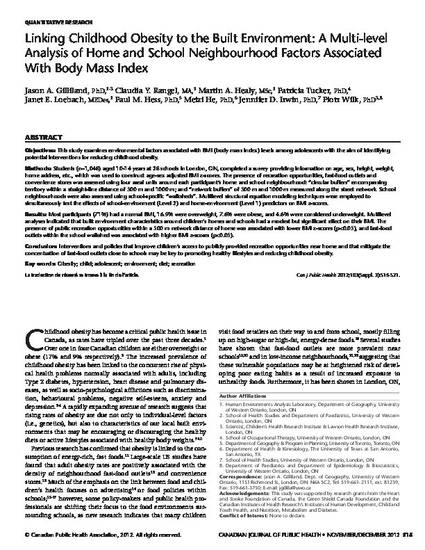
Objectives: This study examines environmental factors associated with BMI (body mass index) levels among adolescents with the aim of identifying potential interventions for reducing childhood obesity.
Methods: Students (n=1,048) aged 10-14 years at 28 schools in London, ON, completed a survey providing information on age, sex, height, weight, home address, etc., which was used to construct age-sex adjusted BMI z-scores. The presence of recreation opportunities, fast-food outlets and convenience stores was assessed using four areal units around each participant’s home and school neighbourhood: “circular buffers” encompassing territory within a straight-line distance of 500 m and 1000 m; and “network buffers” of 500 m and 1000 m measured along the street network. School neighbourhoods were also assessed using school-specific “walksheds”. Multilevel structural equation modeling techniques were employed to simultaneously test the effects of school-environment (Level 2) and home-environment (Level 1) predictors on BMI z-scores.
Results: Most participants (71%) had a normal BMI, 16.9% were overweight, 7.6% were obese, and 4.6% were considered underweight. Multilevel analyses indicated that built environment characteristics around children’s homes and schools had a modest but significant effect on their BMI. The presence of public recreation opportunities within a 500 m network distance of home was associated with lower BMI z-scores (p<0.05), and fast-food outlets within the school walkshed was associated with higher BMI z-scores (p<0.05).
Conclusion: Interventions and policies that improve children’s access to publicly provided recreation opportunities near home and that mitigate the concentration of fast-food outlets close to schools may be key to promoting healthy lifestyles and reducing childhood obesity.

Also available open access in Canadian Journal of Public Health at: https://doi.org/10.1007/BF03403830